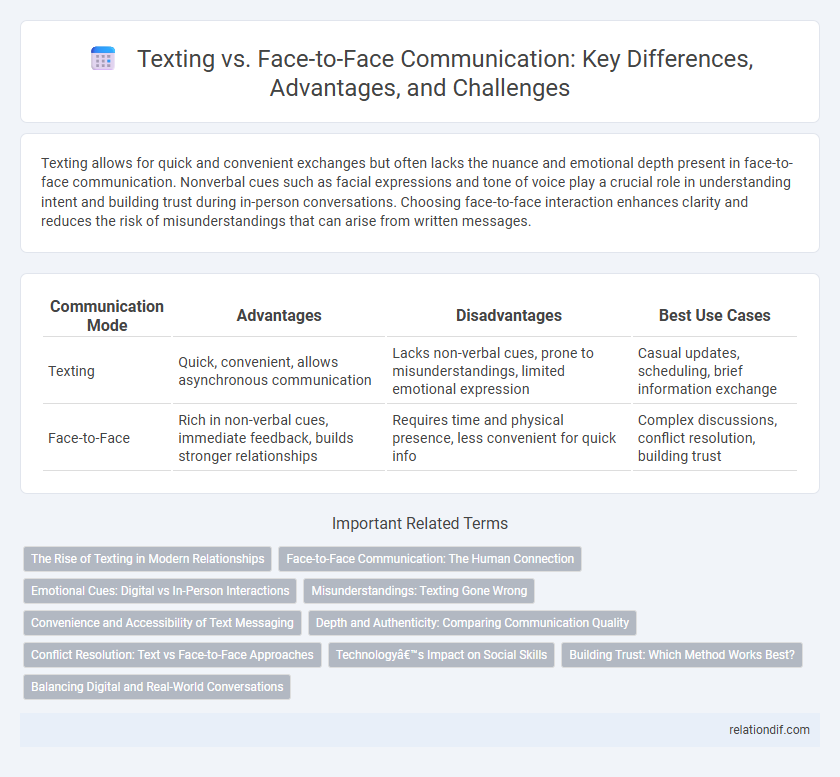Texting allows for quick and convenient exchanges but often lacks the nuance and emotional depth present in face-to-face communication. Nonverbal cues such as facial expressions and tone of voice play a crucial role in understanding intent and building trust during in-person conversations. Choosing face-to-face interaction enhances clarity and reduces the risk of misunderstandings that can arise from written messages.
Table of Comparison
| Communication Mode | Advantages | Disadvantages | Best Use Cases |
|---|---|---|---|
| Texting | Quick, convenient, allows asynchronous communication | Lacks non-verbal cues, prone to misunderstandings, limited emotional expression | Casual updates, scheduling, brief information exchange |
| Face-to-Face | Rich in non-verbal cues, immediate feedback, builds stronger relationships | Requires time and physical presence, less convenient for quick info | Complex discussions, conflict resolution, building trust |
The Rise of Texting in Modern Relationships
Texting has become the dominant form of communication in modern relationships, offering immediate and convenient interaction that fits busy lifestyles. Its rise is attributed to widespread smartphone use, allowing couples to maintain constant connection regardless of physical distance. Despite this, face-to-face communication remains essential for building emotional intimacy and understanding nuanced nonverbal cues.
Face-to-Face Communication: The Human Connection
Face-to-face communication fosters a deeper human connection by enabling individuals to perceive nonverbal cues such as body language, facial expressions, and tone of voice. This richness in interaction promotes empathy, builds trust, and enhances emotional understanding, which texting often lacks due to its reliance on written words alone. Studies show that face-to-face conversations activate mirror neurons, strengthening social bonds and improving conflict resolution.
Emotional Cues: Digital vs In-Person Interactions
Texting lacks the rich emotional cues present in face-to-face communication, such as tone of voice, facial expressions, and body language, which are crucial for interpreting feelings accurately. Digital interactions rely on emojis and punctuation to convey emotions but often lead to misunderstandings due to their limited nuance. In-person communication provides immediate feedback and deeper emotional connection, enhancing empathy and relational understanding.
Misunderstandings: Texting Gone Wrong
Texting often leads to misunderstandings due to the absence of vocal tone, facial expressions, and immediate feedback, which are crucial for interpreting meaning accurately. Misinterpretations of emojis, sarcasm, or brief messages commonly result in confusion or unintended offenses. Face-to-face communication minimizes these risks by allowing real-time clarification, nuanced expression, and stronger emotional connection.
Convenience and Accessibility of Text Messaging
Text messaging offers unparalleled convenience and accessibility, enabling instant communication anytime and anywhere without the need for both parties to be simultaneously available. Mobile devices support seamless texting even in noisy or restricted environments where face-to-face interaction is impractical. The asynchronous nature of texting allows users to respond at their own pace, making it an efficient tool for busy individuals balancing multiple tasks.
Depth and Authenticity: Comparing Communication Quality
Face-to-face communication offers deeper emotional connection and authenticity through nonverbal cues like facial expressions and tone, which texting lacks. Texting often leads to misunderstandings due to limited context and the absence of immediate feedback. Research shows that in-person interactions enhance trust and empathy, fostering stronger relationships compared to digital messaging.
Conflict Resolution: Text vs Face-to-Face Approaches
Texting offers asynchronous communication that allows individuals time to formulate responses and potentially de-escalate initial emotional reactions during conflict resolution. Face-to-face interaction provides immediate feedback through nonverbal cues such as tone, facial expressions, and body language, enhancing mutual understanding and reducing misinterpretations. Research indicates face-to-face conflict resolution is generally more effective in achieving long-term reconciliation and fostering trust compared to texting, which may prolong misunderstandings due to its limited emotional context.
Technology’s Impact on Social Skills
The rapid rise of texting has reshaped social interactions, often reducing opportunities for developing nonverbal communication skills critical in face-to-face conversations. Technology's influence leads to shorter attention spans and diminished empathy, as emotive cues like tone and body language are absent in digital texts. Despite convenience, excessive reliance on texting may hinder deep interpersonal connections and the ability to navigate complex social situations effectively.
Building Trust: Which Method Works Best?
Face-to-face communication significantly enhances trust-building by allowing individuals to interpret nonverbal cues such as body language, tone, and facial expressions, which are absent in texting. Texting, while convenient, often leads to misunderstandings and lacks emotional depth, making it less effective for establishing deep trust. Research shows that in-person interactions foster stronger relational bonds and higher levels of trust compared to digital messaging.
Balancing Digital and Real-World Conversations
Balancing digital and real-world conversations requires understanding the strengths and limitations of texting versus face-to-face communication. Texting offers convenience and quick exchanges but lacks nonverbal cues essential for empathy and deeper connection. Face-to-face interactions foster trust and emotional bonding, making it crucial to prioritize in-person conversations while using digital communication as a complementary tool.
Texting vs Face-to-Face Infographic

 relationdif.com
relationdif.com